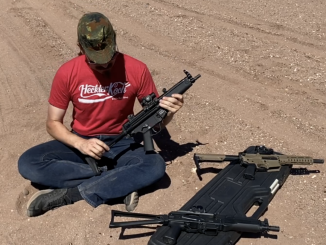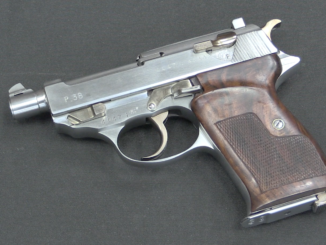The very first group of C96 pistols made. -about 200 in total – are called “System Mauser” pistols. They have this hand-engraved on the top of the barrel, and have a number of other very early features that would quickly change. Most of these changes involve lightening the gun, but they also have a distinctive stepped barrel and a holster/stock that opened to the left; the opposite of all the later standard holsters.
Related Articles

Semiauto Rifles
PCC Showdown: H&K SP5 vs Kalashnikov USA KP9 vs CMMG Banshee
Since SHOT Show this year, I have gotten three different 9mm carbines that are all interesting in their own ways. The Kalashnikov USA KP-9 is a virtual copy of the Russian Vityaz submachine gun, much […]

Heavy MGs
Vintage Saturday: Crew-Served
German WWI Landwehr unit posing with an MG08.

Conversion
John Martz Custom P38s: Babies, .45s, and .38 Supers
Guns in this video: Baby P38 .38 Super P38 .45ACP P38 John Martz was a WWII US Navy veteran who spent a career in metalworking before turning his gunsmithing hobby into a full time occupation […]

For all the esoteric variations of the Broomhandle, may I recommend “System Mauser” by Breathed & Schroeder, still available at not too high a cost. I was obsessed with the C96 early in life and spent a big chunk of cash on the original hardcover, before I quite knew what a locking block was.
I don’t think the actual workings of a Broomhandle have ever had a detailed going-over on this channel. I refer the confused to animations by C&Rsenal, American Gangster, and Noble Empire, all of which show 9mm rather than 7.63 pistols. The second half of this last video shows the locking system best, in my humble opinion.
Thanks for this look at the beginnings of an icon. All that machining time to cut a few grams of weight — could the factory recover all the metal shavings for some use?
Hammer appears different also. Higher arch on the System Mauser?
Johann Basnakowski in Germany is making superb full scale models in aluminum of early conehammers. Not sure if he has tackled these earliest yet. Not for sale though…..would love to have a very early example, even a replica of same.
Where’s the Closed Captions, Ian? 🙁
…I’ve reading the new biography of Churchill, which says that he carried this pistol at Omdurman…possibly saved his life.
Most definitely saved his life. Bought commercially in London, traded in a Webley-Wilkinson for it, and all ten shots came in handy. In his memoirs he recounts with some sadness how very easy it was to kill a man with a pistol — this is the salient difference between Churchill and Hitler: Churchill killed in self-defense and even then rued the need.
Another salient difference of Churchill self-defense: area (city) carpet bombing, begining with Freiburg on May 10, 1940 and a highlighted on Dresden February 13-15, 1945. Check J.M. Spaight ‘Bombing Vindicated”. Probably Winnie was needing something
with more firepower and traded the Mauser for a Lancasters, that’s why he never rued
the need.
Freiburg was bombed by German bombers who mistook it for their assigned target of Dijon in France; this was not proven until 1956. Rotterdam was carpet-bombed four days later by Germany, with the express goal of breaking Dutch resistance. As the Nazis opened the door, the wind blew both ways. My opinion remains that Churchill was morally superior to Hitler and that his expressed opinion of his combat experience is an indicator.
I should say “publicly proven.” The Luftwaffe knew immediately as it found dud bombs on the scene that were German.
LDC. Never proven a Luftwaffe mistake. By the same token, RAF bombed Freiburg on May 15th without excuse. Rotterdam resisted and did not comply with
open city conditions, argument accepted by Dutch Gvmt after the war.
If you are aware of WWII RAF directives regarding city bombing should read about
Lindeman advice to Churchill and/or if you prefer “Bomber” Harris lack of repent
about wiping entire German cities, population included, which makes irrelevant
a selection of any particular target.
If you look after A. Hitler moral shortcomings, yes there was a big one: to be an anglophile.
“(…)was morally superior(…)”
What does that mean?
As a politician our Winston knew crocodile tears outweigh gold
Great video.
No evidence I’ve seen on what exactly Churchill carried at Omdurman in Sept (?) 1898.
With all due respect, Churchill clearly states in his memoirs that he bought a Mauser automatic pistol in London, “then the most modern available,” before shipping out to the Sudan, and details his use of it at Omdurman, including the need to use two hands to cock it. (One of the Churchill biographical sites cites some scholar who traced the sales record.) He retained it as his personal sidearm through civilianhood until he loaned it to someone during the Boer War. His possession of two clips of cartridges caused him some worry after capture by the Boers; he had to surreptitiously ditch them so as not to be executed as a spy or undercover combatant.
The two strippers of cartridges just happened to be loaded with soft points
Churchill would have been shot on the spot if they were found.
He was also there as a freelance journalist, not a combatant, yet he was engaged in a fire fight
Again, that would have earned him a bullet as an irregular / terrorist
Which brings up a point. The Queen’s Regulation stated officers had to buy their own sidearms, which could be of any design as long as they fired the issue (455 in this case) ammunition. Wasn’t the Mauser 7.63mm…How did Leftenant Churchill get around that….Second, what did he carry during his stint as a battalion commander on the Western Front…http://thecasualobserver.co.za/wp-content/uploads/2015/05/Churchill-as-Commander-of-the-Scots-Fusiliers.jpg
I am not sure which pistol WSC carried during WWI, but I do know that in the 1920s he carried a Colt 1911. At the time the IRA were trying to kill him, so the Colt came in handy. I expect the C96 was a bit large for concealed carry.
“(…)Omdurman(…)”
You could read book written by Churchill titled My African Journey here:
http://www.gutenberg.org/ebooks/43035
Ian, please consider changing the color of your shirt and the table cover from black to either light red or light green. The dark colors you commonly use obscure the firearms that you are showing us.
C96’s dropping block lock is guided by a cam, shaped over the lockwork housing and also forced upwards by the front tip of hammer spring (main spring). Being the first on this field the constructors should have been thought that only a single effect might not be safe to direct the action to reach to locked mode. Some handguns like Nambu’s copied those two forcing effects and some like Bergman’s had preferred sole camming only. All constructed afterwards and all having the separate locking block.